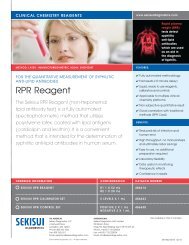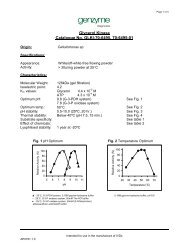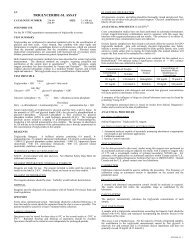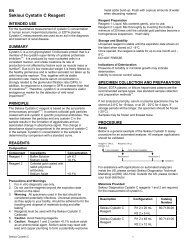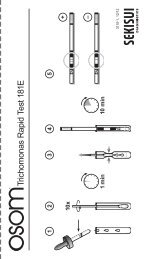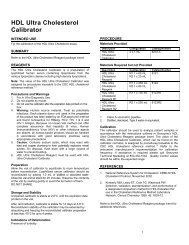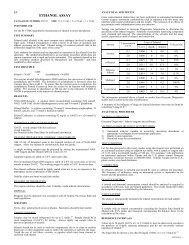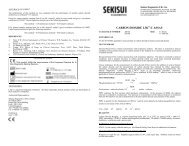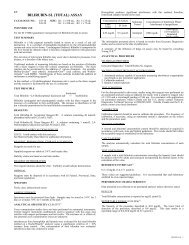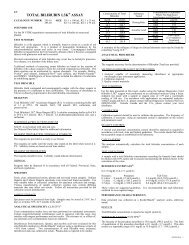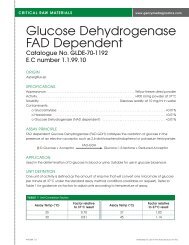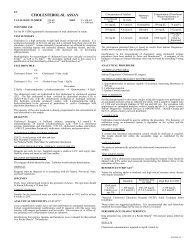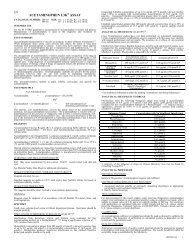LIPASE - Sekisui Diagnostics
LIPASE - Sekisui Diagnostics
LIPASE - Sekisui Diagnostics
Create successful ePaper yourself
Turn your PDF publications into a flip-book with our unique Google optimized e-Paper software.
Genzyme <strong>Diagnostics</strong> P.E.I. Inc.70 Watts Avenue, Charlottetown, PE Canada C1E 2B9Tel: 800-565-0265 ● 902-566-1396 ● Fax: 902-628-6504Email: peidiagnostictechnical@genzyme.comwww.genzymediagnostics.com<strong>LIPASE</strong>CATALOGUE NUMBER: 300-50 SIZE: 10 x 10 mL + 1 x 35 mL300-53 5 x 30 mL + 1 x 50 mLINTENDED USEFor the IN VITRO quantitative measurement of lipase activity in serum.Note: For veterinary laboratory use, additional information is available from technical services.TEST SUMMARYThe measurement of lipase activity in serum and in other fluids is limited, almost without exception, to the evaluation of conditions associatedwith the pancreas. (1)Lipase activity has been measured with a turbidimetric method using triglyceride as the substrate and a colorimetric method using syntheticsubstrates.This assay uses a colorimetric method with a natural substrate, 1,2-diglyceride, and co-lipase and deoxycholate as activators. The method issensitive and specific for pancreatic lipase. (2-6)TEST PRINCIPLEpancreatic lipase1,2-diglyceride + H 2 O → 2-monoglyceride + fatty acidMGLP2-monoglyceride + H 2 O → glycerol + fatty acidGKGlycerol + ATP → glycerol-3-phosphate + ADPGPOGlycerol-3-phosphate + O 2 → dihydroxyacetone phosphate + H 2 O 2POD2H 2 O 2 + 4-aminoantipyrine + TOOS → quinone diimine dye + 4H 2 OMGLP: monoglyceride lipase TOOS: sodium N-ethyl-N-(2-hydroxy-3-sulfopropyl)-m-toluidinePOD: peroxidase GPO: glycerol-3-phosphate oxidaseGK: glycerol kinaseSerum lipase acts on the substrate 1,2-diglyceride to liberate 2-monoglyceride. The 2-monoglyceride is hydrolyzed by monoglyceride lipase intoglycerol and fatty acid.Glycerol kinase acts on glycerol to form glycerol-3-phosphate, which is oxidized by glycerol-3-phosphate oxidase to generate hydrogen peroxide.In the presence of hydrogen peroxide, 4-aminoantipyrine, and TOOS, a quinone dye is produced. The rate of increase in absorbance at 550 nm isproportional to the lipase activity in the sample.REAGENTSEnzyme Substrate: A solution (after reconstitution) containing buffer (pH 6.8 at 25°C), > 860 U/L MGLP (microbial) > 1,330 U/L GK(microbial), > 40,000 U/L GPO (microbial), > 1,330 U/L POD (botanical), > 40,000 U/L co-lipase, 634 mg/L 1,2-diglyceride, 2.3 mM TOOS,and 0.73 mM ATP.Enzyme Substrate Diluent: A solution containing uffer (pH 6.8 at 25°C) and 5.3 mM cholic acid.Activator Solution: A solution containing buffer (pH 8.7 at 25°C), 36 mM deoxycholate, and 5.9 mM 4-aminoantipyrine.WARNINGS & PRECAUTIONS FOR USES24/25: Avoid contact with skin and eyes.Avoid ingestion.See Material Safety Data Sheet for additional information.REAGENT PREPARATION , STORAGE & STABILITYAdd the required volume of enzyme substrate diluent to the enzyme substrate. See vial label. Mix gently, wait one minute, re-mix.The activator solution is ready to use.Supplied reagents stable at 2-8°C until expiry date.Prepared enzyme substrate stable at 2-8°C for 21 days. Stability claims are based on real time studies.
REAGENT DETERIORATIONThe reagent solutions should be clear. Turbidity would indicate deterioration.DISPOSALReagents must be disposed of in accordance with all Federal, Provincial, State, and local regulations.SPECIMENFresh, clear, unhemolysed serum. Serum should be separated immediately after collection and the lipase activity assayed promptly.SAMPLE STORAGESamples should be analyzed within 30 minutes. If this is not possible, samples may be tightly stored at 2-8°C for 2 hours or at -20°C for 24hours. (5)ANALYTICAL SPECIFICITYCross contamination studies have not been performed on automated instruments. Certain reagent/ instrument combinations used in sequence withthis assay may interfere with reagent performance and test results. The existence of, or effects of, any potential cross contamination issues areunknown.Endogenous glycerol interference is eliminated at concentrations less than 100 mg/dL glycerol (10.86 mmol/L glycerol).Interferences from icterus, lipemia, and hemolysis were evaluated for this lipase method on a Roche/Hitachi ® 704 analyzer using a significancecriterion of >10% variance from control. Interference data was collected in serum.Activity of AnalyteSubstanceTestedConcentration of Interferent Where Interference isInsignificant510.5 U/L Hemoglobin 1000 mg/dL 155 μmol/L514.0 U/L Bilirubin 20 mg/dL 342 μmol/L510.0 U/L Intralipid 1000 mg/dL3000 mg/dL (34 μmol/L)Simulated TriglyceridesThe information presented above is based on results from Genzyme <strong>Diagnostics</strong>’ studies and is current at the date of publication.A summary of the influence of drugs on clinical laboratory tests may be found by consulting Young, D.S. (7) .ANALYTICAL PROCEDUREMATERIALS PROVIDEDGenzyme <strong>Diagnostics</strong>’ Lipase reagents.MATERIALS REQUIRED (BUT NOT PROVIDED)1. Automated analyzer capable of accurately measuring absorbance at 550 nm.2. Calibration material (Lipase Calibrator, Cat. No. SE-050 is appropriate for use).3. Quality Control materials.TEST CONDITIONFor the data presented in this insert, studies using this reagent were performed using a rate test mode, with a sample to reagent ratio of 1:80 and aprimary wavelength reading of 550 nm. For assistance with applications on automated analyzers within Canada and the U.S., please contactGenzyme <strong>Diagnostics</strong> Technical Services at (800)565-0265. Outside Canada and the U.S., please contact your local distributor.CALIBRATIONCalibration material should be used to calibrate the procedure. Cat. No. SE-050 is available from Genzyme <strong>Diagnostics</strong> for this purpose. Thefrequency of calibration, if necessary, using an automated system is dependent on the system and the parameters used.QUALITY CONTROLA normal and abnormal concentration control should be analyzed as required in accordance with local, state and federal guidelines. The resultsshould fall within the acceptable ranges established by the laboratory.CALCULATIONSThe analyzer automatically calculates the lipase activity of each sample.TEST LIMITATIONSA sample with lipase activity exceeding the linearity limit should be diluted with 0.9% saline and reassayed incorporating the dilution factor inthe calculation of the value.REFERENCE INTERVALS (7)7.2-59.3 U/L (37°C)These values are suggested guidelines. It is recommended that each laboratory establish its own expected range.
PERFORMANCE CHARACTERISTICSRESULTSLipase activity is reported as U/L.REPORTABLE RANGEThe generic procedure is linear to 600.0 U/L. Linearity using automated procedures will depend on the sample/reagent ratio used.PRECISION STUDIESTotal precision was established by assaying two control sera six separate times.Activity (U/L)Total SD(U/L)Total CV%Activity (U/L)Within Run SD(U/L)Within RunCV %42 1.8 4.2 43 0.8 1.8252 6.0 2.4 269 4.2 1.6Within run precision was established by assaying two control sera twenty times.ACCURACYA comparison was made between this method and Ektachem 700 using 99 samples ranging from 0-600 U/L. The correlation coefficient was0.9945. Linear regression analysis gave the following equation:This method = 0.2815 (reference method) - 8.73 U/L.The information presented above is based on results from Genzyme <strong>Diagnostics</strong>’ studies and is current at the date of publication.REFERENCES1. Tietz, N.W. (Ed.), Fundamentals of Clinical Chemistry, W.B. Saunders Co., Toronto, 635 (1982).2. Imamura, S. and Misaki, H.: "A sensitive method for assay of lipase activity by coupling with β-oxidation enzymes of fatty acid." SelectedTopics in Clinical Enzymology 2:73, 1984.3. Imamura, S. et.al.: "A method using 1,2-diglyceride as substrate for assay of lipase activity by coupling with β-oxidation enzymes of fattyacid" Collection of summaries of lectures in the 126th general meeting of Kinki Branch, Analytical Section, Japan Society of ClinicalChemistry, p.11-31, 1986.4. Hayashi, C. and et.al.: "Assay methods for human lipases" Clinical Examination, Instrument and Reagent, 2:225, 1986.5. Kitaura, S. et.al.: "Properties of monoglyceride lipase produced by thermophilic bacteria" Collection of summaries of lectures in the 61thgeneral meeting of The Japanese Biochemical Society, 848, 1988.6. Imamura, S. et.al., Clin., Chem., Abstract Issue in the 41st National Meeting, 1120, 1989.7. Young, D.S., Effects of Drugs on Clinical Laboratory Tests, AACC Press, Washington, Third Edition, 1990.Definitions for SymbolsAll trademarks, brands, product names and trade names are the property of their respective companies.IN30050-15April 2, 2009



